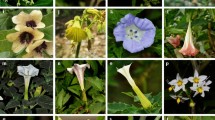Abstract
Floral nectaries in theLimnanthaceae are established as exoscopic basal bulges of the episepalous stamens. Their nectariferous tissues include the epidermis and hypodermal parenchyma and inLimnanthes are vascularized by phloematic branches of the staminal bundles. Secretion occurs mainly through anomocytic stomata but, in addition, probably through the outer cuticularized thin walls of the epidermal cells. The flower structure is comparatively simple. The nectar is often slightly concealed. A wide range of pollinators can be expected, but bees are observed to be the dominant ones. The systematic position of the family is still obscure. Taxonomic placement near to any other geranialian families or to theCaryophyllaceae is only weakly justified.
Similar content being viewed by others
References
Baillon, H., 1878: The natural history of plants.Geraniales 5: 1–66. — London.
Brown, W. H., 1938: The bearing of nectaries on the phylogeny of flowering plants. — Proc. Amer. Phil. Soc.79: 549–595.
Buchner, R., Halbritter, H., Pfundner, G., Hesse, M., 1990: Pollen ofLimnanthes douglasii: a reinvestigation. — Grana29: 207–211.
Core, E. L., 1964: Plant taxonomy.Geraniales, pp. 287, 339–347, 4th edn. — New Jersey: Englewood Cliffs.
Cronquist, A., 1968: The evolution and classification of flowering plants. — London: Nelson.
—, 1981: An integrated system of classification of flowering plants. — New York: Columbia University Press.
Eckert, G., 1966: Entwicklungsgeschichte und blütenanatomische Untersuchungen zu Problemen der Obdiplostemonie. — Bot. Jahrb. Syst.85: 523–604.
Eichler, A. W., 1878: Blütendiagramme. I., II. — Reprint Eppenheim (1954).
Erdtman, G., 1952: Pollen morphology and plant taxonomy. Angiosperms. — Chronica Botanica. Waltham, Mass.: Sinauer.
Eysel, G., 1937: Die Embryosackentwicklung vonLimnanthes douglasii R. Br. — Dissertation, University of Marburg.
Gentry, H. S., Miller, R. W., 1965: The search for new industrial crops IV. Prospectus ofLimnanthes. — Econ. Bot.19: 25–32.
Gersterberger, P., Leins, P., 1978: REM-Untersuchungen an Blütenknospen vonPhysalis philadelphica (Solanaceae). Anwendung einer neuen Präparationsmethode. — Ber. Deutsch. Bot. Ges.91: 381–387.
Gibbs, R. D., 1965: A classical taxonomist's view of chemistry in taxonomy of higher plants. — Lloydia28: 279–299.
Hallier, H., 1908: ÜberJuliania, eineTerebinthaceen-Gattung mit Cupula, und die wahren Stammeltern der Kätzchenblütler — Dresden.
—, 1921: Zur morphologischen Deutung der Diskusgebilde in der Dicotylenblüte. — Meded. Rijksherb. Leiden41: 1–14.
—, 1923: Beiträge zur Kenntnis derLinaceae (DC.)Dumort. — Beih. Bot. Centralbl.39(2): 1–179.
Hofmann, U., Ludewig, J., 1985: Morphologie und systematische Stellung vonLimnanthes douglasii R. Brown, einem repräsentativen Vertreter derLimnanthaceae. — Bot. Jahrb. Syst.105: 401–431.
Hutchinson, J., 1969: Evolution and phylogeny of flowering plants. — London, New York: Academic Press.
Huynh, K.-L., 1971: The morphological development of the pollen ofLimnanthes douglasii (Limnanthaceae). — Grana Palynol.11: 58–61.
Johri, B. M., Maheshwari, P., 1951: The embryo sac ofFloerkea proserpinacoides Willd. — Curr. Sci.20: 44–46.
Kalin Arroyo, M. T. K., 1973: Chiasma frequency evidence on the evolution of autogamy inLimnanthes floccosa (Limnanthaceae). — Evolution27: 679–688.
Knuth, P., 1898: Handbuch der Blütenbiologie. 2, Teil 1. — Leipzig: Engelmann.
Link, D. A., 1992: The floral nectaries of theGeraniales and their systematic implications I.Geraniaceae Knuth. — Beitr. Biol. Pflanzen (in press).
Maheshwari, J. K., Johri, B. M., 1956: Morphology and embryology ofFloerkea proserpinacoides with a discussion on the systematic position of the familyLimnanthaceae. — Bot. Mag. (Tokyo)69: 410–423.
Mason, C. T., 1951: Development of the embryosac in the genusLimnanthes. — Amer. J. Bot.38: 17–22.
Mathur, N., 1956: The embryology ofLimnanthes. — Phytomorphology6: 41–51.
Ornduff, R., Crovello, T. J., 1968: Numerical taxonomy ofLimnanthaceae. — Amer. J. Bot.55: 173–182.
Payer, J.-B., 1857: Traité d'organogenie comparée de la fleur. — Paris.
Pflumm, W., 1985: Influence of nectar-supply rate on the number of flowers visited by honeybee on each collecting flight. — Oecologia (Berlin)66: 207–210.
Reiche, K., 1897:Limnanthaceae. — InEngler, A., Prantl, K. A. E., (Eds.): Die natürlichen Pflanzenfamilien 3/5, pp. 136–137, 1st edn. Leipzig: Engelmann.
Russell, A. M., 1919: A comparative study ofFloerkea proserpinacoides and allies. — Contrib. Bot. Lab. Univ. of Pennsylvania4: 401–418.
Saunders, E. R., 1937: Floral morphology. A new outlook with special reference to the interpretation of the gynoeceum. 1. — Cambridge, England: Heifer.
Scholz, H., 1964:Zygophyllaceae. — InMelchior, H., (Ed.):Engler's Syllabus der Pflanzenfamilien, pp. 251–252. — Berlin-Nikolassee: Bornträger.
Smith, B. H., 1983a: Demography ofFloerkea proserpinacoides, a forestfloor annual I. Density-dependent growth and mortality. — J. Ecol.71: 391–404.
—, 1983b: Demography ofFloerkea proserpinacoides, a forestfloor annual II. Densitydependent reproduction. — J. Ecol.71: 405–412.
Stenar, H., 1925: Embryologische und zytologische Studien überLimnanthes R. Br. — Svensk Bot. Tidskr.19: 133–152.
Trelease, W., 1888: A study of North AmericanGeraniaceae. — Mem. Boston Soc. Nat. Hist.4: 71–104.
Zandonella, P., 1972: Le nectaire floral desCentrospermales. — Thèse Université Lyon.
Author information
Authors and Affiliations
Additional information
The floral nectaries of theGeraniales and their systematic implications II. For the first part seeLink (1992).
Rights and permissions
About this article
Cite this article
Link, D.A. The floral nectaries in theLimnanthaceae . Pl Syst Evol 179, 235–243 (1992). https://doi.org/10.1007/BF00937599
Received:
Accepted:
Issue Date:
DOI: https://doi.org/10.1007/BF00937599




